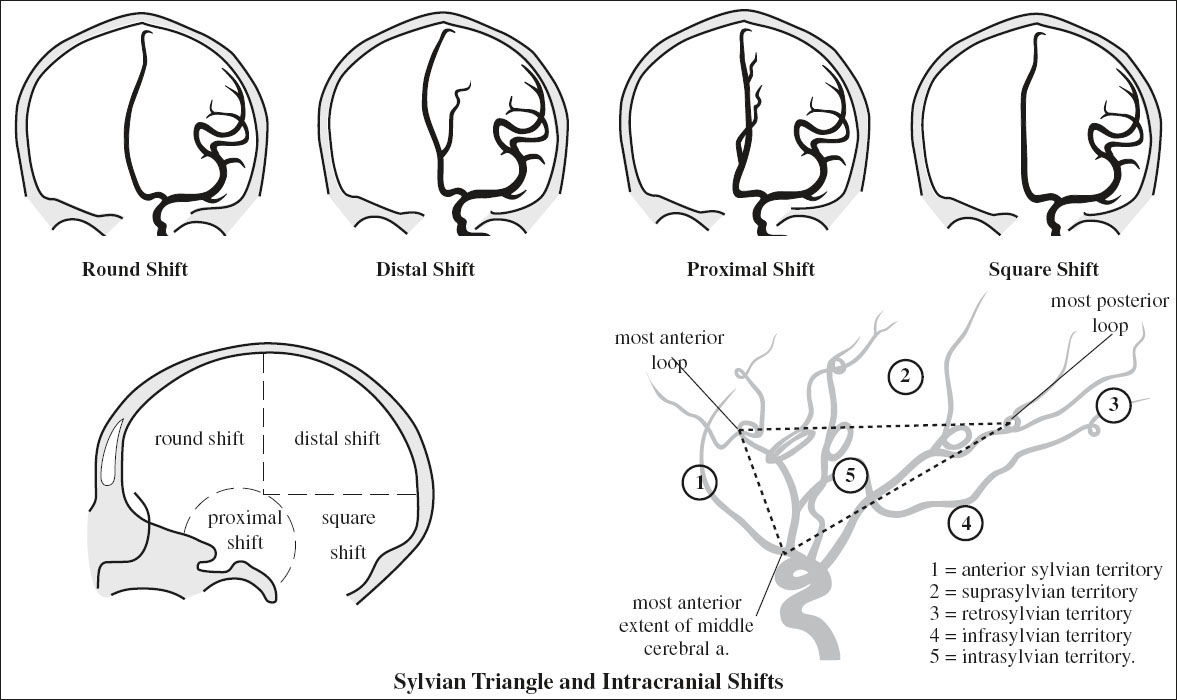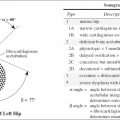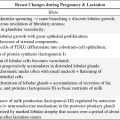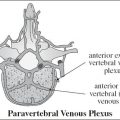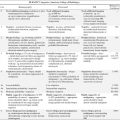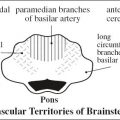TRIGEMINAL NEUROPATHY
• facial pain, numbness, weakness of masticatory muscles, trismus
• diminished / absent corneal reflex
• abnormal jaw reflex; atrophy of masticatory muscles
• decreased pain / touch / temperature sensation
• tic douloureux = paroxysmal facial pain (usually confined to V2 and V3) mainly ← neurovascular compression (tortuous elongated superior cerebellar artery / anterior inferior cerebellar artery / vertebrobasilar dolichoectasia / venous compression)
A. BRAINSTEM LESION
1. Vascular: infarct, AVM
2. Neoplastic: glioma, metastasis
3. Inflammatory: multiple sclerosis (1–8%), herpes rhombencephalitis
4. Other: syringobulbia
B. CISTERNAL CAUSES
1. Vascular: aneurysm, AVM, vascular compression
2. Neoplastic: acoustic schwannoma, meningioma, trigeminal schwannoma, epidermoid cyst, lipoma, metastasis
3. Inflammatory: neuritis
C. MECKEL CAVE + CAVERNOUS SINUS
1. Vascular: carotid aneurysm
2. Neoplastic: meningioma, trigeminal schwannoma, epidermoid cyst, lipoma, pituitary adenoma, base of skull neoplasm, metastasis, perineural tumor spread
3. Inflammatory: Tolosa-Hunt syndrome
D. EXTRACRANIAL
1. Neoplastic: neurogenic tumor, squamous cell carcinoma, adenocarcinoma, lymphoma, adenoid cystic carcinoma, mucoepidermoid carcinoma, melanoma, metastasis, perineural tumor spread
2. Inflammatory: sinusitis
3. Other: masticator space abscess, trauma
HORNER SYNDROME
= syndrome ← interruption of oculosympathetic pathway:
• ipsilateral blepharoptosis; pupillary miosis; facial anhidrosis
Oculosympathetic pathway:
(a) 1st order neuron: posterolateral hypothalamus → brainstem → intermediolateral column of spinal cord → exit at C8, T1, T2
(b) 2nd order preganglionic neuron: ventral spinal root → arch over apex of lung → cervical sympathetic chain → superior cervical ganglion
(c) 3rd order postganglionic neuron: with carotid artery → cavernous sinus → ophthalmic branch of cranial nerve V
A. CENTRAL HORNER (uncommon)
Location: hypothalamus, thalamus, brainstem, cervical cord
Cause: infarction of PICA / distal vertebral artery
• hypothalamic / brainstem / spinal cord signs
B. PREGANGLIONIC HORNER
Location: cervicothoracic cord, brachial plexus, anterior neck, mediastinum
Cause: trauma, lung (Pancoast) / mediastinal tumor, lesion in cervical spinal cord / brachial plexus
C. POSTGANGLIONIC HORNER
Location: superior cervical ganglion, internal carotid artery, cavernous sinus, orbital apex
Cause: ICA dissection / aneurysm, carotid-cavernous fistula / thrombophlebitis, inflammation (Tolosa-Hunt syndrome), skull base tumor
CLASSIFICATION OF CNS ANOMALIES
A. DORSAL INDUCTION ANOMALY
= defects of neural tube closure
1. Anencephaly
2. Cephalocele at 4 weeks
3. Chiari malformation at 4 weeks
4. Spinal dysraphism
5. Hydromyelia
B. VENTRAL INDUCTION ANOMALY
= defects in formation of brain vesicles + face
1. Holoprosencephaly: 5–6 weeks
2. Septo-optic dysplasia: 6–7 weeks
3. Dandy-Walker malformation: 7–10 weeks
4. Agenesis of septum pellucidum
C. NEURONAL PROLIFERATION & HISTOGENESIS
1. Neurofibromatosis: 5 weeks–6 months
2. Tuberous sclerosis: 5 weeks–6 months
3. Primary hydranencephaly: > 3 months
4. Neoplasia
5. Vascular malformation (vein of Galen, AVM, hemangioma)
D. NEURONAL MIGRATION ANOMALY
due to infection, ischemia, metabolic disorders
1. Schizencephaly: 2 months
2. Agyria + pachygyria: 3 months
3. Gray matter heterotopia: 5 months
4. Dysgenesis of corpus callosum: 2–5 months
5. Lissencephaly
6. Polymicrogyria
7. Unilateral megalencephaly
E. DESTRUCTIVE LESION
1. Hydranencephaly
2. Porencephaly
3. Hypoxia: periventricular leukomalacia, germinal matrix hemorrhage
5. Infections (TORCH)
(a) Toxoplasmosis
(b) Other: syphilis, hepatitis, zoster
(c) Rubella
√ punctate / nodular calcifications
√ porencephalic cysts
√ occasionally microcephaly
(d) Cytomegalovirus inclusion disease
√ typically punctate / stippled / curvilinear periventricular calcifications
√ often hydrocephalus
(e) Herpes simplex
Absence of Septum Pellucidum
1. Holoprosencephaly
2. Callosal agenesis
3. Septo-optic dysplasia
4. Schizencephaly
5. Severe chronic hydrocephalus
6. Destructive porencephaly
Phakomatoses
[ phako , Greek = lens / lentil-shaped object]
= NEUROCUTANEOUS SYNDROMES = NEUROECTODERMAL DYSPLASIAS
= development of benign tumors / malformations in organs of ectodermal origin (CNS, eye, skin)
(a) autosomal dominant:
1. Neurofibromatosis (von Recklinghausen)
2. Tuberous sclerosis (Bourneville)
3. Retinocerebellar hemangioblastoma (Von Hippel-Lindau)
4. Neurocutaneous melanosis
(b) not autosomal dominant:
5. Encephalotrigeminal angiomatosis (Sturge-Weber-Dimitri)
6. Ataxia-telangiectasia
DEGENERATIVE DISEASES OF HEMISPHERES
= progressive fatal disease characterized by destruction / alteration of gray and white matter
Etiology: genetic; viral infection; nutritional disorders (eg, anorexia nervosa, Cushing syndrome); immune system disorders (eg, AIDS); exposure to toxins (eg, CO); exposure to drugs (eg, alcohol, methotrexate + radiation)
Myelinoclastic / Demyelinating Disease
= disease that destroys normally formed myelin
◊ Usually affects older children / adults
(a) infectious
1. Progressive multifocal leukoencephalopathy
2. Subacute sclerosing panencephalitis (SSPE)
3. Acute disseminated encephalomyelitis (ADEM)
(b) noninfectious
1. Radiation
2. Anoxia
3. Hypertensive encephalopathy
4. Disseminated necrotizing leukoencephalopathy (from methotrexate therapy)
(c) others
1. Multiple sclerosis (most frequent of primary demyelinating disease)
2. Alzheimer disease (most common of diffuse gray matter degenerative diseases)
3. Parkinson disease (most common of subcortical degenerative disease)
4. Creutzfeldt-Jakob disease
5. Menkes disease (sex-linked recessive disorder of copper metabolism)
6. Globoid cell leukodystrophy
7. Spongiform degeneration
8. Cockayne syndrome
9. Spongiform leukoencephalopathy
10. Myelinoclastic diffuse sclerosis (= Schilder disease)
Dysmyelinating Disease
= metabolic disorder (= enzyme deficiency) resulting in deficient / absent myelin sheaths
◊ Usually presents in first 2 years / 1st decade of life!
◊ Associated with white matter atrophy
(a) macrencephalic:
1. Alexander disease (frontal areas affected first)
2. Canavan disease (white matter diffusely affected)
(b) hyperdense thalami, caudate nuclei, corona radiata
1. Krabbe disease
(c) family history (X-linked recessive)
1. X-linked adrenoleukodystrophy
2. Pelizaeus-Merzbacher disease
(d) others
1. Metachromatic leukodystrophy (most common hereditary leukodystrophy)
2. Binswanger disease (SAE)
3. Multi-infarct dementia (MID)
4. Pick disease
5. Huntington disease
6. Wilson disease
7. Reye syndrome
8. Mineralizing microangiopathy
9. Diffuse sclerosis
VASCULAR DISEASE OF BRAIN
Classification of Vascular CNS Anomalies
A. VASCULAR MALFORMATION
(a) arterial = arteriovenous malformation (AVM)
1. Classic brain AVM
2. Cerebral proliferative angiopathy
3. Cerebrofacial arteriovenous metameric syndrome
2. Vein of Galen malformation
(b) capillary = capillary telangiectasia
1. Capillary telangiectasia
2. Facial port-wine stain
(c) venous = venous malformation
1. Developmental venous anomaly
2. Sinus pericranii
(d) lymphatic
1. Cystic hygroma
(e) combinations
1. Sturge-Weber disease
2. Rendu-Osler-Weber disease
B. VASCULAR TUMOR
1. Hemangioma
(a) capillary hemangioma: seen in children, involution by 7 years of age in 95%
(b) cavernous hemangioma: seen in adults, no involution
2. Hemangiopericytoma
3. Hemangioendothelioma
4. Angiosarcoma
Blunt Cerebrovascular Injury
= carotid (CA) + vertebral artery (VA) injuries during generalized multitrauma / direct craniocervical trauma
Prevalence: 1.1–1.6% of all blunt trauma
Mechanism: partial / complete failure of arterial mural integrity ← longitudinal stretching of artery, direct blow to artery, piercing by bone fragment
Prognosis: 25–38% mortality if injury untreated
Cx: (1) Infarction ← intimal disruption / flap / hematoma
→ thromboembolism of platelet aggregates
→ critical luminal stenosis + occlusion
(2) Brain ischemia ← steal phenomenon by AV fistula
(3) Fatal exsanguination
Type of Arterial Injury
1. Minimal intimal injury
√ nonstenotic luminal irregularity
DDx: arterial spasm
2. Raised intimal flap
√ linear intraluminal filling defect emanating from arterial wall
3. Dissection with intramural hematoma
√ eccentric / circumferential mural thickening:
√ narrowed arterial lumen
√ increased arterial diameter
4. Arterial occlusion
√ lack of intraluminal enhancement
5. Pseudoaneurysm
√ eccentric outpouching from native arterial lumen:
√ minimal contour abnormality
√ large irregular saccular outpouching
√ focal ballooning of arterial lumen
6. Transection with active hemorrhage
√ irregular collection of extravascular contrast material surrounding parent vessel
7. Arteriovenous fistula
√ early venous enhancement during the arterial phase
√ enlargement of draining vein
DDx: (1) Atherosclerosis (presence of calcification, characteristic location, increasing age)
Location: vessel origin, carotid bulb, cavernous carotid segment
(2) Coiled / looped cervical ICA segment (5–15%)
(3) Congenitally absent / small ICA (small / absent carotid canal)
Shunt Lesions of Cerebral Vasculature
1. AV malformation
2. AV fistula: pia, dura, carotid-cavernous sinus
3. Vein of Galen malformation
Congenital Venous Lesions
1. Developmental venous anomaly
2. Cerebral cavernous malformation
3. Sinus pericranii
Occlusive Vascular Disease
(a) Embolic state:
√ single vascular territory
(b) Hypoperfusive state:
√ multiple vascular territories
Cause:
1. Vasospasm from subarachnoid hemorrhage
2. Embolic infarction (50%)
(a) thrombus (atrial fibrillation, valvular disease, atheromatous plaques of extracerebral arteries, fibromuscular dysplasia, intracranial aneurysm, surgery, paradoxic emboli, sickle cell disease, atherosclerosis, thrombotic thrombocytopenic purpura)
• fluctuating blood pressures; hypercoagulability
√ cerebral petechial hemorrhage within cortical / basal gray matter during 2nd week (from fragments of embolus) in up to 40%; initial ischemia is followed by reperfusion (= HALLMARK of embolic infarction)
√ “supernormal artery” on NECT = high-density material lodged in cerebral vessel near major bifurcations
√ atheromatous narrowing of vessels
(b) fat
(c) nitrogen
3. Watershed / border zone infarct (10%)
4. Hypertension
(a) Hypertensive encephalopathy
√ diffuse white matter hypodensity (edema ← arterial spasm)
(b) Hypertensive hemorrhage
Location: basal ganglia (putamen, external capsule), thalamus, pons, cerebellum
(c) Lacunar infarction
(d) Subcortical arteriosclerotic encephalopathy
5. Amyloidosis involvement of small- + medium-sized arteries of meninges + cortex
• normotensive patient > 65 years of age
√ multiple simultaneous / recurrent cortical hemorrhages
6. Vasculitis
(a) Bacterial meningitis, TB, syphilis, fungus, virus, rickettsia
(b) Collagen-vascular disease: Wegener granulomatosis, polyarteritis nodosa, SLE, scleroderma, dermatomyositis
(c) Granulomatous angiitis: giant cell arteritis, sarcoidosis, Takayasu disease, temporal arteritis
(d) Inflammatory arteritis: rheumatoid arteritis, hypersensitivity arteritis, Behçet disease, lymphomatoid granulomatosis
(e) Drug-induced: IV amphetamine, ergot preparations, oral contraceptives
(f) Radiation arteritis = mineralizing microangiopathy
(g) Moyamoya disease
7. Anoxic encephalopathy cardiorespiratory arrest, near-drowning, drug overdose, CO poisoning
8. Venous thrombosis
Multiple Infarctions
◊ Typical in extracranial occlusive disease, cardiac output problems, small vessel disease; in 6% from a shower of emboli
Location: usually bilateral + supratentorial (¾); supra- and infratentorial (¼)
Reversal Sign
= inversion of the normal attenuation relationship between gray and white matter (gray matter of lower attenuation than adjacent white matter of thalami, brainstem, cerebellum) on NECT of brain
Pathogenesis: not fully understood
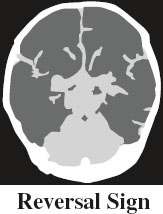
Cause: global cerebral injury with anoxic insult ← head trauma, nonaccidental trauma, hypoxia, drowning, status epilepticus, hypothermia, bacterial meningitis, strangulation
Prognosis: poor ← irreversible brain damage; survivors with profound neurologic deficits + severe developmental delay
Diffusion Weighted Imaging (DWI)
Hyperintense Lesion on DWI
1. Cerebral infarction
2. Epidermoid inclusion cyst
3. Abscess with pus
4. Encephalitis of cortex
5. Creutzfeldt-Jakob disease
6. Trauma: axonal shearing injury
7. Neoplasm: medulloblastoma
INNUMERABLE PUNCTATE HYPERINTENSE LESIONS ON DWI
= Starfield pattern
1. Diffuse axonal injury (trauma)
2. Emboli: cardiogenic, septic, fat
3. Vasculitis
4. Minute hemorrhagic metastases
Hypointense Lesion on DWI
1. CSF
2. Tumor cyst: pilocytic, hemangioblastoma
3. Tumor nodules: hemangioblastoma
False Penumbra on Perfusion CT
True penumbra: successfully treatable with thrombolysis
√ mean transit time (MTT) ↑
√ cerebral blood flow (CBF) ↓
√ cerebral blood volume (CBV) ↔
False penumbra: area of abnormal perfusion as in ischemic penumbra NOT treatable with thrombolysis
A. Atherosclerosis at carotid bifurcation
= upstream flow limitation WITHOUT significant intracranial collateral blood supply
√ carotid bulb disease by CT angiography
B. Evolving ischemic condition / chronic infarct
= delayed reperfusion + vascular collateralization of incomplete acute / chronic infarct
√ hypoattenuation in the same region
√ restricted diffusion on DWI + ADC map
C. Vascular dysregulation
= hyperemia on symptomatic side with apparent perfusion abnormality on contralateral normal side
• clinical history!
Cause:
1. Hypertensive encephalopathy (PRES)
√ perfusion abnormality ← vasospasm
√ hyperintensity on STIR sequence
√ no restricted diffusion
2. Seizure, subarachnoid hemorrhage, hemiplegic migraine
• seizure activity
√ no restricted diffusion
D. Head tilt / angulation
E. Variations in cerebrovascular anatomy
= physiologic perfusion delay in circle of Willis variants, unequal blood supply between anterior + posterior circulation, congenitally absent ICA, etc.
CNS Vasculitis
A. LARGE-VESSEL VASCULITIS
1. Takayasu arteritis
2. Giant cell arteritis = Temporal arteritis
B. MEDIUM-SIZED–VESSEL VASCULITIS
1. Polyarteritis nodosa
√ aneurysm / stenosis / occlusion of intracranial carotid arteries
2. Kawasaki disease
√ nonspecific subdural effusion, cerebral infarction
√ reversible hyperintense lesion in splenium
C. SMALL-VESSEL VASCULITIS
1. IgA vasculitis = Henoch-Schönlein purpura
√ hypertensive encephalopathy
√ focal ischemic / hemorrhagic lesions
2. Microscopic polyangiitis
√ cerebral hemorrhage + infarction, pachymeningitis
√ variable degree of small-vessel disease
3. Granulomatosis with polyangiitis = Wegener granulomatosis
√ leptomeningeal enhancement
4. Eosinophilic granulomatosis with polyangiitis = Churg-Strauss syndrome
√ macro- / microinfarctions + macro- / microhemorrhages
√ optic neuropathy
D. VARIABLE-SIZED VESSEL VASCULITIS
1. Behçet disease
2. Cogan syndrome
√ nonspecific ischemic changes
√ obliteration / narrowing of vestibular labyrinth
E. SINGLE-ORGAN VASCULITIS
1. Primary angiitis of CNS (PACNS)
√ discrete / diffuse supra- and infratentorial lesions
√ ± areas of infarction and hemorrhage
F. VASCULITIS OF SYSTEMIC DISEASE
1. Systemic lupus erythematosus (SLE)
√ subcortical + periventricular white matter hyperintensity (60%)
√ cerebral atrophy (30%), intracranial hemorrhage (3%)
2. Sjögren syndrome
√ extensive white + gray matter lesions + microbleeds
3. Rheumatoid arthritis
√ pachymeningitis with leptomeningeal enhancement
√ cerebral vasculitis (rare)
4. APLA (antiphospholipid antibody) syndrome
√ arterial / venous thrombosis, thrombocytopenia
5. Scleroderma
√ nonspecific infarction, macro- and microhemorrhages
G. VASCULITIS WITH PROBABLE ETIOLOGY
1. Infection-induced vasculitis
2. Acute septic meningitis
√ cerebral infarcts (5–15% in adults, 30% in neonates)
3. Mycobacterium tuberculosis
√ vasculitis of smaller cerebral arteries → small infarcts in basal ganglia
4. Neurosyphilis
√ predominantly MCA stroke in young adult
5. Viral (in childhood):
› HIV-related vasculitis
√ aneurysm, vessel occlusion, embolic disease, venous thrombosis
› Varicella-zoster vasculopathy
√ uni- / bilateral basal ganglia infarcts
6. Fungal: mucormycosis aspergillosis
7. Parasitic: cysticercosis
8. Malignancy-induced vasculitis
9. Drug-induced vasculitis
√ vasculitis, vasospasm, infarction, moyamoya-like
› heroin
√ spongiform leukoencephalopathy
10. Radiation-induced vasculitis
√ wall thickening + prominent wall enhancement in affected large arteries
11. Reversible cerebral vasoconstriction syndrome: Call-Fleming syndrome, postpartum angiopathy, migrainous vasospasm, benign angiopathy of CNS, vasoactive substances (cannabis, selective serotonin recapture inhibitors, nasal decongestants)
Imaging signs of cerebral vasculitis:
(a) direct
√ vessel wall thickening
√ vessel wall enhancement with contrast material
(b) indirect
√ cerebral perfusion deficit
√ ischemic brain lesion
√ intracerebral / subarachnoid hemorrhage
√ vascular stenosis
BRAIN ATROPHY
Cerebral Atrophy
= irreversible loss of brain substance + subsequent enlargement of intra- and extracerebral CSF-containing spaces (hydrocephalus ex vacuo = ventriculomegaly)
A. DIFFUSE BRAIN ATROPHY
Cause:
(a) Trauma, radiation therapy
(b) Drugs: dilantin, steroids, methotrexate, marijuana, hard drugs, chemotherapy, alcohol, hypoxia
(c) Demyelinating disease: multiple sclerosis, encephalitis
(d) Degenerative disease: eg, Alzheimer disease, Pick disease, Jakob-Creutzfeldt disease
(e) Cerebrovascular disease + multiple infarcts
(f) Advancing age, anorexia, renal failure
√ enlarged ventricles + sulci
B. FOCAL BRAIN ATROPHY
Cause: vascular / chemical / metabolic / traumatic / idiopathic (Dyke-Davidoff-Mason syndrome)
C. REVERSIBLE PROCESS SIMULATING ATROPHY
(in younger people)
Cause: anorexia nervosa, alcoholism, catabolic steroid treatment, pediatric malignancy
√ prominent sulci
√ ipsilateral dilatation of basal cisterns + ventricles
√ ex vacuo dilatation of ventricles
√ thinning of gyri
√ focal areas of periventricular high signal intensity
√ increased iron deposition in putamen approaching the concentration in globus pallidus
√ dilatation of Virchow-Robin perivascular space
Cerebellar Atrophy
A. WITH CEREBRAL ATROPHY
= generalized senile brain atrophy
B. WITHOUT CEREBRAL ATROPHY
1. Olivopontocerebellar degeneration / Marie ataxia / Friedreich ataxia
• onset of ataxia in young adulthood
2. Ataxia-telangiectasia
3. Ethanol toxicity: predominantly affecting midline (vermis)
4. Phenytoin toxicity: predominantly affecting cerebellar hemispheres
5. Idiopathic degeneration 2° to carcinoma (= paraneoplastic), usually oat cell carcinoma of lung
6. Radiotherapy
7. Focal cerebellar atrophy: (a) infarction
(b) traumatic injury
Hippocampal Atrophy
1. Alzheimer Disease
2. Mesial temporal sclerosis
• complex partial seizures
3. Normal in octogenarians
BRAIN HERNIATION
= shift of normal brain from high to low pressure through rigid structures of skull ← ⇑ intracranial pressure
Cause: mass effect by primary / metastatic tumor, trauma, infection (abscess) / inflammation, intracranial hemorrhage, subdural hematoma, ischemia / infarction, acute hydrocephalus, iatrogenic (after lumbar puncture / pneumocephalus following craniotomy)
Classification:
A. SUPRATENTORIAL HERNIATION
1. Uncal (transtentorial)
2. Central
3. Cingulate (subfalcine)
4. Transcalvarial
5. Tectal (posterior)
B. INFRATENTORIAL HERNIATION
1. Upward (upward cerebellar / upward transtentorial)
2. Tonsillar (downward cerebellar)
Subfalcine / Cingulate Herniation (most common)
= contralateral shift of midline structures under falx cerebri
= herniation of cingulate gyrus across falx cerebri
Risk: compression of one of anterior cerebral arteries
May be associated with: transtentorial herniation
• weakness / paresis of contralateral leg ← compression of parafalcine cortex
• weakness ± sensory changes of contralateral leg ← infarction of paracentral lobule / superior frontal gyrus ← compression of ACA / pericallosal artery
• somnolence ← raised intracranial pressure
√ early signs:
@ falx
√ shift of ipsilateral cingulate gyrus beneath falx
√ deviation of anterior falx with widened CSF space at contralateral side
N.B.: posterior falx remains relatively undisplaced due to greater height + rigidity
@ cingulate gyrus
√ compression of contralateral cingulate gyrus
@ corpus callosum
√ depression of ipsilateral corpus callosum
√ depression / elevation of contralateral corpus callosum
@ ventricle
√ compression / effacement of ipsilateral ventricle with amputation of ipsilateral frontal horn
√ late signs:
√ displacement of lateral ventricle to opposite side
√ obstruction of foramen of Monro → contralateral dilatation of the lateral ventricle + subependymal edema
√ infarction of cingulate gyrus
√ compression of anterior cerebral artery → infarction of ACA territory
Assessment: degree of greatest displacement of septum pellucidum / falx measured in mm relative to a straight line drawn through anterior and posterior falcine attachments on axial image
Prognosis: good with shift of < 5 mm; poor with shift > 15 mm
Cx: traumatic aneurysm of ACA / pericallosal artery
Transtentorial (Central) Herniation
= herniation of brain up / down across tentorium cerebelli
Tentorium cerebelli = inelastic reflection of dura
Connected to: occipital bone posteriorly, petrous temporal bone laterally, clinoid processes anteriorly
Content: transverse sinus, straight sinus
Tentorial hiatus / incisura
Content: cerebral peduncles + brainstem
Alert: NO lumbar puncture with effacement of basal cisterns + displacement of 4th ventricle!
Descending Transtentorial Herniation
= downward herniation of brain toward posterior fossa
• oculomotor nerve (cranial n. III) palsy:
• ipsilateral dilated pupil (= mydriasis) due to uncal herniation → compression of parasympathetic fibers traveling on outside of CN III → unopposed sympathetic activity to iris sphincter m.
• abnormal extraocular muscle function (except for superior oblique m., lateral rectus m., levator palpebrae superioris m.)
• ipsilateral hemiparesis (on side of expanding lesion) (false localizing sign = Kernohan notch syndrome) due to severe lateral translation of midbrain against opposite tentorial edge → compression of opposite corticospinal tracts above decussation
• permanent anterograde amnesia ← infarction of uncal / parahippocampal gyrus ← arterial compression
• permanent visual field defect ← temporal / occipital lobe infarction ← compression of calcarine branch of PCA against tentorium
Location and degree of herniation:
(a) anterior / uncal herniation (see below)
(b) posterior: herniation of parahippocampal gyrus
(c) total: herniation of entire hippocampus
√ compression of ipsilateral cerebral peduncle
√ compression of contralateral cerebral peduncle → notching of midbrain (= Kernohan notch)
√ compression of aqueduct of Sylvius → early dilatation of temporal horn → obstructive hydrocephalus
√ widening of contralateral temporal horn
√ widening (obliteration) of ipsilateral (contralateral) basilar (ambient + quadrigeminal) cisterns
Cx:
(1) Occipital infarction ← compression of ipsilateral posterior cerebral artery against cerebral peduncle by uncus + parahippocampal gyrus
√ effacement / displacement of ipsilateral PCA
(2) Duret hemorrhage = hemorrhage in median / paramedian mesencephalon / tectum ← stretching of pontine perforators ← downward displacement of pons
(3) Respiratory arrest
UNCAL / ANTERIOR TRANSTENTORIAL HERNIATION
= herniation of uncus (most medial part of temporal lobe) across tentorium cerebelli into suprasellar cistern
◊ Most common subtype of transtentorial herniation caused by lesions in anterior half of brain
√ uncus displaced into suprasellar cistern → pressure on midbrain + brainstem
√ truncation of six-pointed star appearance of suprasellar cistern
Risk: (1) compression of midbrain (brainstem)
(3) Kernohan notch syndrome
Ascending Transtentorial / Cerebellar Herniation
= displacement of cerebellum through tentorial incisura superiorly = upward (superior vermian) displacement
Cause: slowly growing cerebellar / brainstem process, infarction
• nausea & vomiting → obtundation → coma
√ compression + anterior displacement of 4th ventricle
√ occlusion of aqueduct → obstructive hydrocephalus
√ narrowing / effacement of ambient + quadrigeminal cistern
√ compression of pons against clivus
√ upward displacement of cerebellar vermis
√ superior displacement of tectum
√ “spinning top” appearance of midbrain due to bilateral compression on posterolateral aspect of midbrain
√ downward displacement of cerebellar tonsils
Cx: (1) basilar artery compression ← displacement of midbrain / pons against clivus
(2) compression of vein of Galen / basal vein of Rosenthal → parenchymal congestion
(3) compression of posterior cerebral + superior cerebellar arteries ← superior displacement of cerebellum
Alar / Transalar / Retroalar / Sphenoid Herniation
= herniation of frontal lobe posteriorly across edge of sphenoid ridge
Associated with: transtentorial + subfalcine herniation
• paucity of clinical symptomatology, clinically occult
› posterior / descending: frontal lobe mass
√ frontal lobe displaced posteriorly
√ posterior displacement of sylvian fissure, temporal lobe + horizontal segment of MCA
› anterior / ascending: temporal lobe / insula lesion
√ temporal lobe displaced anteriorly
Transforaminal / Tonsillar Herniation
= herniation of inferior mesial portions of cerebellum (= inferior tonsils) downward through foramen magnum
Commonly associated with: ascending (⅔) or descending (⅓) transtentorial herniation
• neck pain, nystagmus, vomiting (in conscious patient)
• Cushing response (= irregular respiration, bradycardia, hypertension) as warning sign in unconscious patient
• decerebrate posturing
Risk: compression of medulla → respiratory arrest → cardiovascular collapse → coma → death
√ cerebellar tonsils at level of dens on axial images
√ cerebellar tonsils ≥ 5 mm below foramen magnum (= line connecting basion with opisthion) in adults; ≥ 7 mm in children on sagittal / coronal images
√ effacement of 4th ventricle / aqueduct → hydrocephalus of 3rd + lateral ventricles with transependymal CSF flow
√ ± concurrent upward displacement of vermis
Cx: compression of vulnerable PICA → cerebellar infarction
Alert: Known complication of lumbar puncture performed in context of elevated intracranial pressure!
Transcalvarial / External Herniation
= brain protrusion through fracture / surgical site of skull
Displacement of Vessels
A. ARTERIAL SHIFT
(a) Pericallosal arteries
1. Round shift = frontal lesion anterior to coronal suture
2. Square shift = lesion behind foramen of Monro in lower half of hemisphere
3. Distal shift = posterior to coronal suture in upper half of hemisphere
4. Proximal shift = basifrontal lesion / anterior middle cranial fossa including anterior temporal lobe
(b) Sylvian triangle
= branches of MCA within sylvian fissure on outer surface of insula form a loop upon reaching the upper margin of the insula; serves as angiographic landmark for localizing supratentorial masses
Location of lesion:
| › | anterior sylvian | frontal region |
| › | suprasylvian | posterior frontal + parietal |
| › | retrosylvian | occipital, parietooccipital |
| › | infrasylvian | temporal lobe + extracerebral region |
| › | intrasylvian | usually due to meningioma |
| › | lateral sylvian | frontal, frontotemporal, parietotemporal |
| › | central sylvian | deep posterior frontal, basal ganglia |
B. CEREBRAL VEINS
= indicate the midline of the posterior part of the forebrain showing the exact location of the roof of the 3rd ventricle
BRAIN MASSES
Classification of Primary CNS Tumors
Incidence: 9% of all primary neoplasms (5th most common primary neoplasm); 5–10÷100,000 population per year; account for 1.2% of autopsied deaths
A. TUMORS OF BRAIN AND MENINGES
(a) Gliomas
ASTROCYTOMA (50%)
1. Astrocytoma (astrocytoma grades I–II)
2. Glioblastoma (astrocytoma grades III–IV)
OLIGODENDROGLIOMA
PARAGLIOMA
1. Ependymoma
2. Choroid plexus papilloma
GANGLIOGLIOMA
MEDULLOBLASTOMA
(b) Pineal tumor
1. Germinoma
2. Teratoma
3. Pineocytoma
4. Pineoblastoma
(c) Pituitary tumor
1. Pituitary adenoma
2. Pituitary carcinoma
(d) Meningioma
(e) Nerve sheath tumor
1. Schwannoma
2. Neurofibroma
(f) Miscellaneous
1. Sarcoma
2. Lipoma
3. Hemangioblastoma
B. TUMORS OF EMBRYONAL REMNANTS
(a) Craniopharyngioma
(b) Colloid cyst
(c) Teratoid tumor
1. Epidermoid (0.2–1.8%)
2. Dermoid
3. Teratoma
CNS Tumors Presenting at Birth
1. Hypothalamic astrocytoma
2. Choroid plexus papilloma / carcinoma
3. Teratoma
4. Primitive neuroectodermal tumor
5. Medulloblastoma
6. Ependymoma
7. Craniopharyngioma
CNS Tumors in Pediatric Age Group
Prevalence:
2.4÷100,000 (< 15 years of age); 2nd most common pediatric tumor (after leukemia); 15% of all pediatric neoplasms; 15–20% of all primary brain tumors; M > F
• increased intracranial pressure
• increasing head size
A. SUPRATENTORIAL (50%)
Age: first 2–3 years of life
| Covering of brain | : | dural sarcoma, schwannoma, meningioma (3%) |
| Cerebral hemisphere | : | astrocytoma (37%), oligodendroglioma |
| Corpus callosum | : | astrocytoma |
| 3rd ventricle | : | colloid cyst, ependymoma |
| Lateral ventricle | : | ependymoma (5%), choroid plexus papilloma (12%) |
| Optic chiasm | : | craniopharyngioma (12%), optic nerve glioma (13%), teratoma, pituitary adenoma |
| Hypothalamus | : | glioma (8%), hamartoma |
| Pineal region | : | germinoma, pinealoma, teratoma (8%) |
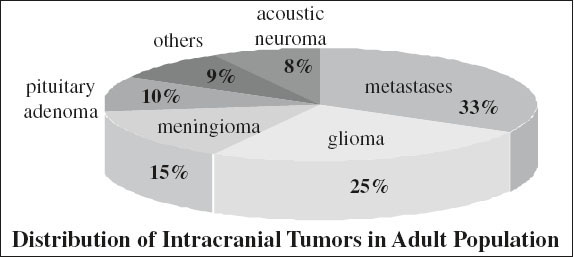
Incidence of Brain Tumors | |||
| All Age Groups | Pediatric Age Group | ||
Glioma | 34% | Astrocytoma | 50% |
Meningioma | 17% | Medulloblastoma | 15% |
Metastasis | 12% | Ependymoma | 10% |
Pituitary adenoma | 6% | Craniopharyngioma | 6% |
Neurinoma | 4% | Choroid plexus papilloma | 2% |
Sarcoma | 3% | ||
Granuloma | 3% | ||
Craniopharyngioma | 2% | ||
Hemangioblastoma | 2% | ||
Differences of Some Pediatric CNS Tumors | |||
| PNET | Ependymoma | Astrocytoma |
CT | hyper | iso | hypo |
T2WI | intermed. | intermed. | increased |
Enhancement | moderate | minimal | nodule |
Calcification | 10–15% | 40–50% | < 10% |
Cyst formation | rare | common | typical |
CSF seeding | 15–40% | rare | rare |
Foraminal spread | no | yes | no |
B. INFRATENTORIAL (50%)
Age: 4–11 years
| Cerebellum | : | astrocytoma (31–33%), PNET / medulloblastoma (26–31%) |
| Brainstem | : | glioma (16–21%) |
| 4th ventricle | : | ependymoma (6–14%), choroid plexus papilloma |
mnemonic: “BE MACHO”
Brainstem glioma
Ependymoma
Medulloblastoma
AVM
Cystic astrocytoma
Hemangioblastoma
Other
Supratentorial Tumor with Mural Nodule
1. Extraventricular ependymoma
2. Pleomorphic xanthoastrocytoma
3. Hemispheric pilocytic astrocytoma
4. Ganglioglioma
5. Dysembryoplastic neuroepithelial tumor (DNET)
Supratentorial Midline Tumors
1. Optic + hypothalamic glioma (39%)
2. Craniopharyngioma (20%)
3. Astrocytoma (9%)
4. Pineoblastoma (9%)
5. Germinoma (6%)
6. Lipoma (6%)
7. Teratoma (3.5%)
8. Pituitary adenoma (3.5%)
9. Meningioma (2%)
10. Choroid plexus papilloma (2%)
Classification by Histology
1. Astrocytic tumors (33.5%)
2. “Primitive” neuroectodermal tumor = PNET (21%)
› Medulloblastoma (16%)
› Ependymoblastoma (2.5%)
› PNET of cerebral hemisphere (2.5%)
3. Mixed gliomas (16%)
4. Malformative tumors (11.5%)
› Craniopharyngioma (5.5%)
› Lipoma (4.5%)
› Dermoid cyst (1%)
› Epidermal cyst (0.5%)
5. Choroid plexus tumors (4%)
6. Ependymal tumors (4%)
7. Tumors of meningeal tissues (3.5%)
› Meningioma (3%)
› Meningeal sarcoma (0.5%)
8. Germ cell tumors (2.5%)
› Germinoma (1.5%)
› Teratomatous tumor (1%)
9. Neuronal tumors
› Gangliocytoma (1.5%)
10. Tumors of neuroendocrine origin
› Pituitary adenoma (1%)
11. Oligodendroglial tumors (0.5%)
12. Tumors of blood vessel
› Hemangioma (1%)
Superficial Gliomas
= peripherally located cortical neoplasms serving as a seizure focus
1. Ganglioglioma
2. Desmoplastic infantile ganglioglioma
3. Gangliocytoma
4. Dysplastic cerebellar gangliocytoma
5. Pleomorphic xanthoastrocytoma
6. Dysembryoplastic neuroepithelial tumor
Multifocal CNS Tumors
A. METASTASES FROM PRIMARY CNS TUMOR
(a) via commissural pathways: corpus callosum, internal capsule, massa intermedia
(b) via CSF: ventricles / subarachnoid cisterns
(c) satellite metastases
B. MULTICENTRIC CNS TUMOR
(a) true multicentric gliomas (4%)
(b) concurrent tumors of different histology (coincidental)
C. MULTICENTRIC MENINGIOMAS (3%) without neurofibromatosis
D. MULTICENTRIC PRIMARY CNS LYMPHOMA
E. PHAKOMATOSES
1. Generalized neurofibromatosis:
meningiomatosis, bilateral acoustic neuromas, bilateral optic nerve gliomas, cerebral gliomas, choroid plexus papillomas, multiple spine tumors, AVMs
2. Tuberous sclerosis:
subependymal tubers, intraventricular gliomas (giant cell astrocytoma), ependymomas
3. Von Hippel-Lindau disease:
retinal angiomatosis, hemangioblastomas, congenital cysts of pancreas + liver, benign renal tumors, cardiac rhabdomyomas
Multifocal Deep Hemispheric Masses
1. Primary CNS Lymphoma
2. Gliomatosis cerebri
√ nonenhancing tumor extension (common)
CNS Tumors Metastasizing Outside CNS
mnemonic: MEGO
Medulloblastoma
Ependymoma
Glioblastoma multiforme
Oligodendroglioma
Large Heterogeneous Intracerebral Mass
1. High-grade glioma
√ increased relative cerebral blood volume (rCBV) in zone of edema on perfusion-weighted images
2. Metastasis
√ reduced relative cerebral blood volume (rCBV) in zone of edema on perfusion-weighted images
Mass with Large Tumor Vessels and Edema
1. Glioblastoma multiforme
2. Meningioma
Avascular Mass of Brain
mnemonic: TEACH
Tumor: astrocytoma, metastasis, oligodendroglioma
Edema
Abscess
Cyst, Contusion
Hematoma, Herpes
Calcified Intracranial Mass
1. Oligodendroglioma (frequent, although rare tumor)
2. Low-grade astrocytoma (in 10–20%)
mnemonic: Ca2+ COME
Craniopharyngioma
Astrocytoma, Aneurysm
Choroid plexus papilloma
Oligodendroglioma
Meningioma
Ependymoma
HYPODENSE BRAIN LESIONS
Diffusely Swollen Hemispheres
A. METABOLIC
1. Metabolic encephalopathy: eg, uremia, Reye syndrome, ketoacidosis
2. Anoxia: cardiopulmonary arrest, near-drowning, smoke inhalation, ARDS
B. NEUROVASCULAR
1. Hypertensive encephalopathy
2. Superior sagittal sinus thrombosis
3. Head trauma
4. Pseudotumor cerebri
C. INFLAMMATION / INFECTION
eg, herpes encephalitis, CMV, toxoplasmosis
Brain Edema
= increase in brain volume ← increased tissue-water content (80% for gray matter + 68% for white matter is normal)
Etiology:
(a) Cytotoxic edema
reversible increase in intracellular water content 2° to ischemia / anoxia (axonal pallor) → depletion of ATP → ion pump dysfunction across glial cell membrane → increase in intracellular Na+ and K+
• characteristically seen in cerebral infarction
• 30–60 min after onset of symptoms
√ decreased ADC value (dark)
(b) Vasogenic edema (most common form)
fluid leakage of water out of capillaries into extracellular interstitial space ← damage of capillary endothelium; increase in pinocytotic activity with passage of protein across vessel wall into intercellular space
• associated with primary brain neoplasm, metastases, hemorrhage, inflammation, infarction
• takes > 3–6 hours; requires residual / reestablished blood flow
√ lack of contrast enhancement means breakdown of blood-brain barrier is NOT the cause
√ increased ADC value (bright)
DDx: blood-brain barrier break-down after 8–10 days
Types:
1. Hydrostatic edema
rapid increase / decrease in intracranial pressure
2. Interstitial edema
increase in periventricular interstitial spaces ← transependymal flow of CSF with elevated intraventricular pressure
3. Hypo-osmotic edema
produced by overhydration from IV fluid / inappropriate secretion of antidiuretic hormone
4. Congestive brain swelling
rapid accumulation of extravascular water as a result of head trauma; may become irreversible (brain death) if intracranial pressure equals systolic blood pressure
√ decreased distinction between gray + white matter
√ compressed slitlike lateral ventricles
√ compression of cerebral sulci + perimesencephalic cisterns
CT:
√ areas of hypodensity
◊ Edema is always greatest in white matter!
√ mass effect: flattening of gyri, displacement + deformation of ventricles, midline shift
√ return to normal: from nonhemorrhagic edema / brain atrophy, from white matter shearing injury
MR:
√ decreased intensity on T1WI
√ increased intensity on T2WI
√ enhancement with gadolinium
US:
√ generalized / focal increase of parenchymal echogenicity with featureless appearance
√ decreased resistive indices
Midline Cyst
1. Cavum septi pellucidi
2. Cavum vergae
3. Cavum veli interpositi
4. Colloid cyst anterior + superior to cavum septi pellucidi
5. Arachnoid cyst in region of quadrigeminal plate cistern
√ curvilinear margins
Intracranial Nonneoplastic Cyst
Characteristics:
√ no detectable wall / associated soft-tissue mass
√ homogeneous signal intensity identical to CSF
√ absence of surrounding edema / gliosis
√ NO contrast enhancement
1. Choroid plexus cyst (most common, abnormal DWI in ⅔)
2. Ependymal cyst
3. Neuroglial cyst
4. Enlarged perivascular spaces (typically multiple, clustered around basal ganglia)
5. Arachnoid cyst (typically extraaxial)
6. Porencephalic cyst (communication with lateral ventricle, surrounding gliosis)
7. Infectious cyst of neurocysticercosis (< 1 cm, partially enhancing)
8. Epidermoid cyst
Cyst with Mural Nodule
1. Ependymoma
2. Pilocytic astrocytoma (childhood)
3. Pleomorphic xanthoastrocytoma
4. Ganglioglioma
5. Glioblastoma multiforme
6. Hemangioblastoma (posterior fossa, spinal cord)
Multiple Tiny CNS Cysts
A. DIFFUSE DEGENERATIVE DISEASE
B. DIFFUSE INFLAMMATORY PROCESS
C. LOW-GRADE CYSTIC NEOPLASM
1. Ganglioglioma
2. Pyelocytic astrocytoma
3. Pleomorphic xanthoastrocytoma
Anterior Temporal Cysts with Leukoencephalopathy
1. Congenital CMV infection
2. Leukoencephalopathy with subcortical temporal cysts and megalencephaly
3. Vanishing white matter disease
Cystic Lesions on Head Ultrasound
A. NORMAL VARIANTS
1. Cavum septi pellucidi
2. Cavum vergae
3. Cavum veli interpositi
B. CYSTIC LESIONS OF POSTERIOR FOSSA
Evaluate
› size of 4th ventricle + communication with 4th ventricle
› size of vermis + cerebellar hemispheres
› mass effect on cerebellum
1. Megacisterna magna
2. Dandy-Walker continuum disorder
3. Blake pouch cyst
4. Arachnoid cyst
5. Vein of Galen malformation
B. SUPRATENTORIAL PERIVENTRICULAR CYSTS
1. Connatal cyst
= coarctation of lateral ventricles + frontal horn cysts
Location: at / just below superolateral angles of frontal horns / body of lateral ventricles anterior to foramen of Monro
Cause: normal variant ← approximation of walls of frontal horns; NOT sequelae of ischemia
2. Subependymal cyst
3. Choroid plexus cyst
4. Periventricular leukomalacia
4. Pseudoporencephaly
C. SUPRATENTORIAL INTRA- / EXTRAAXIAL CYSTS
1. Schizencephaly
2. Ventriculomegaly: hydrocephalus, brain atrophy
3. Holoprosencephaly
4. Supratentorial arachnoid cyst
5. Spontaneous intracranial hematoma
6. Brain abscess (uncommon)
Cholesterol-containing CNS Lesions
1. Epidermoid inclusion cyst
2. Cholesterol granuloma
3. Acquired epidermoid of middle ear
4. Congenital cholesteatoma of middle ear
5. Craniopharyngioma
Mesencephalic Low-density Lesion
1. Normal: decussation of superior cerebellar peduncles at level of inferior colliculi
2. Syringobulbia found in conjunction with syringomyelia, Arnold-Chiari malformation, trauma
√ CSF density centrally
√ intrathecal contrast enters central cavity
3. Brainstem infarction
√ abnormal contrast enhancement after 1 week
√ well-defined low-attenuation region without enhancement after 2–4 weeks
4. Central pontine myelinolysis
5. Brainstem glioma
6. Metastasis
√ well-defined contrast enhancement
7. Granuloma in TB / sarcoidosis (rare)
Intracranial Pneumocephalus
A. TRAUMA (74%):
in 3% of all skull fractures; in 8% of fractures involving paranasal sinuses (frontal > ethmoid > sphenoid > mastoid) or base of skull
(b) penetrating injury
B. NEOPLASM INVADING SINUS (13%):
1. Osteoma of frontal / ethmoid sinus
2. Pituitary adenoma
3. Mucocele, epidermoid
4. Malignancy of paranasal sinuses
C. INFECTION WITH GAS-FORMING ORGANISM (9%) in mastoiditis, sinusitis
D. SURGERY (4%)
hypophysectomy, paranasal sinus surgery
E. SUPRATENTORIAL CRANIOTOMY
Location: in any compartment; most often in subdural space over frontal lobe
Duration after surgery: 2 days (100%), 7 days (75%), 2nd week (60%), 3rd week (26%), > 3 weeks (0%)
Mechanism of dural laceration:
(1) ball-valve mechanism during straining, coughing, sneezing
(2) vacuum phenomenon ← loss of CSF
Time of onset: on initial presentation (25%), usually seen within 4–5 days, delay up to 6 months (33%)
Mortality: 15%
Cx: (1) CSF rhinorrhea (50%)
(2) Meningitis / epidural / brain abscess (25%)
(3) Extracranial pneumocephalus = air collection in subaponeurotic space
HYPERDENSE INTRACRANIAL LESIONS
Intracranial Calcifications
mnemonic: PINEEAL
Physiologic
Infection
Neoplasm
Endocrine
Embryologic
Arteriovenous
Leftover Ls
A. PHYSIOLOGIC INTRACRANIAL CALCIFICATIONS
B. INFECTION
TORCH (toxoplasmosis, others [syphilis, hepatitis, zoster], CMV, rubella, herpes), healed abscess, hydatid cyst, granuloma (tuberculoma, actinomycosis, coccidioidomycosis, cryptococcosis, mucormycosis), cysticercosis, trichinosis, paragonimiasis
mnemonic:
CMV calcifications are circumventricular
Toxoplasma calcifications are intraparenchymal
C. NEOPLASM
Craniopharyngioma (40–80%), oligodendroglioma (50–70%), chordoma (25–40%), choroid plexus papilloma (10%), meningioma (20%), pituitary adenoma (3–5%), pinealoma (10–20%), dermoid (20%), lipoma of corpus callosum, ependymoma (50%), astrocytoma (15%), after radiotherapy, metastases (1–2%, lung > breast > GI tract)
N.B.: Astrocytomas calcify less frequently but are the most common tumor!
D. ENDOCRINE Hyperparathyroidism, hypervitaminosis D, hypoparathyroidism, pseudohypoparathyroidism, CO poisoning, lead poisoning
E. EMBRYOLOGIC Neurocutaneous syndromes (tuberous sclerosis, Sturge-Weber, neurofibromatosis), Fahr disease, Cockayne syndrome, basal cell nevus syndrome
F. ARTERIOVENOUS Atherosclerosis, aneurysm, AVM, occult vascular malformation, hemangioma, subdural + epidural hematomas, intracerebral hemorrhage
G. LEFTOVER Ls
Lipoma, lipoid proteinosis, lissencephaly
Physiologic Intracranial Calcification
1. Pineal calcification
Age: no calcification < 5 years of age, in 8–10% at 8–14 years of age, in 40% by 20 years of age; in ⅔ of adult population
√ amorphous / ringlike calcification < 3 mm from midline usually < 10 mm in diameter
√ ~ 30 mm above highest posterior elevation of pyramids
CAVE: pineal calcification > 14 mm suggests pineal neoplasm (teratoma / pinealoma)
Stay updated, free articles. Join our Telegram channel

Full access? Get Clinical Tree


